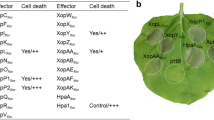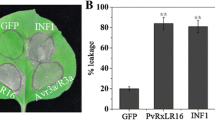Abstract
Main conclusion
Xanthomonas campestris pv. campestris 8004 secretes several effector proteins that interfere with plant phosphorylation.
Abstract
Xanthomonas campestris pv. campestris (Xcc) can infect cruciferous plants and cause black rot. The strain Xcc8004 secretes effector proteins that interfere with plant cellular processes into host cells using a type III secretion (T3S) system. Several of the 24 predicted T3S effectors in the Xcc8004 genome have been implicated in the suppression of the Arabidopsis thaliana pattern-triggered immunity (PTI) response. We used an A. thaliana mesophyll protoplast-based assay to identify Xcc8004 T3S effectors that effectively interfere with PTI signalling induced by the bacterial peptide flg22. 11 of the 24 tested effector proteins (XopK, XopQ, HrpW, XopN, XopAC, XopD, XopZ1, XopAG, AvrBs2, XopL and XopX-1) inhibited expression of the flg22-inducible gene FRK1, and five effectors (XopK, XopG, XopQ, XopL and XopX-1) inhibited the expression of the flg22-inducible gene WRKY33. Therefore, there are 12 effector proteins that can inhibit the expression of relevant flg22-inducible genes. It was further investigated whether the 12 effector proteins affect the phosphorylation activation of mitogen-activated protein (MAP) kinases MPK3/MPK6, and four effector proteins (XopK, XopQ, XopZ1 and XopX-1) were found to markedly inhibit MPK3/MPK6 activation. Moreover, a subcellular localisation analysis revealed that the tested effectors were localised within various subcellular compartments. These results indicate that multiple T3S effectors in the Xcc8004 genome interfere with flg22-induced PTI signalling via various molecular mechanisms.






Similar content being viewed by others
References
Asai T, Tena G, Plotnikova J, Willmann MR, Chiu WL, Gomez-Gomez L, Boller T, Ausubel FM, Sheen J (2002) MAP kinase signalling cascade in Arabidopsis innate immunity. Nature 415:977–983
Bozkurt TO, Schornack S, Banfield MJ, Kamoun S (2012) Oomycetes, effectors, and all that jazz. Curr Opin Plant Biol 15:483–492
Büttner D (2016) Behind the lines-actions of bacterial type III effector proteins in plant cells. FEMS Microbiol Rev 40:894–937
Cai Y, Jia T, Lam SK, Ding Y, Gao C, San MW, Pimpl P, Jiang L (2011) Multiple cytosolic and transmembrane determinants are required for the trafficking of SCAMP1 via an ER-Golgi-TGN-PM pathway. Plant J 65(6):882–896
Dean P (2011) Functional domains and motifs of bacterial type III effector proteins and their roles in infection. FEMS Microbiol Rev 35:1100–1125
Deslandes L, Rivas S (2012) Catch me if you can: bacterial effectors and plant targets. Trends Plant Sci 17:644–655
Dodds PN, Rathjen JP (2010) Plant immunity: towards an integrated view of plant-pathogen interactions. Nat Rev Genet 11(8):539–548
Felix G, Duran JD, Volko S, Boller T (1999) Plants have a sensitive perception system for themost conserved domain of bacterial flagellin. Plant J 18:265–276
Feng F, Zhou JM (2012) Plant-bacterial pathogen interactions mediated by type III effectors. Curr Opin Plant Biol 15:469–476
Feng F, Yang F, Rong W, Wu X, Zhang J, Chen S, He C, Zhou JM (2012) A Xanthomonas uridine 5'-monophosphate transferase inhibits plant immune kinases. Nature 485:114–118
Fraiture M, Zheng X, Brunner F (2014) An Arabidopsis and tomato mesophyll protoplast system for fast identification of early MAMP-triggered immunity-suppressing effectors. Methods Mol Biol 1127:213–230
Gimenez-Ibanez S, Hann DR, Ntoukakis V, Petutschnig E, Lipka V, Rathjen JP (2009) AvrPtoB targets the lysM receptor kinase CERK1 to promote bacterial virulence on plants. Curr Biol 19:423–429
Göhre V, Robatzek S (2008) Breaking the barriers: microbial effector molecules subvert plant immunity. Annu Rev Phytopathol 46:189–215
Göhre V, Spallek T, Häweker H, Mersmann S, Mentzel T, Boller T, de Torres M, Mansfield JW, Robatzek S (2008) Plant pattern-recognition receptor FLS2 is directed for degradation by the bacterial ubiquitin ligase AvrPtoB. Curr Biol 18:1824–1832
Gómez-Gómez L, Boller T (2000) FLS2: an LRR receptor-like kinase involved in the perception of the bacterial elicitor flagellin in Arabidopsis. Mol Cell 5:1003–1011
Guo M, Tian F, Wamboldt Y, Alfano JR (2009) The majority of the type III effctor inventory of Pseudomonas syringae pv. tomato DC3000 can suppress plant immunity. Mol Plant-Microbe Interact 22:1069–1080
He P, Shan L, Lin NC, Martin GB, Kemmerling B, Nürnberger T, Sheen J (2006) Specific bacterial suppressors of MAMP signalling upstream of MAPKKK in Arabidopsis innate immunity. Cell 125:563–575
Heilmann RM, Allenspach K (2017) Pattern-recognition receptors: signalling pathways and dysregulation in canine chronic enteropathies-brief review. J Vet Diagn Invest 29:781–787
Hogenhout SA, Van der Hoorn RA, Terauchi R, Kamoun S (2009) Emerging concepts in effector biology of plant-associated organisms. Mol Plant Microbe Interact 22:115–122
Hueck CJ (1998) Type III protein secretion systems in bacterial pathogens of animals and plants. Microbiol Mol Biol Rev 62:379–433
Jiang BL, He YQ, Cen WJ, Wei HY, Jiang GF, Jiang W, Hang XH, Feng JX, Lu GT, Tang DJ, Tang JL (2008) The type III secretion effector XopXccN of Xanthomonas campestris pv. campestris is required for full virulence. Res Microbiol 159:216–220
Jones JD, Dangl JL (2006) The plant immune system. Nature 444:323–329
Li JF, Zhang D, Sheen J (2014) Epitope-tagged protein-based artificial miRNA screens for optimized gene silencing in plants. Nat Protoc 9(4):939–949
Liu X, Luo M, Zhang W, Zhao J, Zhang J, Wu K, Tian L, Duan J (2012) Histone acetyltransferases in rice (Oryza sativa L.): phylogenetic analysis, subcellular localization and expression. BMC Plant Biol 12:145
Liu L, Wang Y, Cui F, Fang A, Wang S, Wang J, Wei C, Li S, Sun W (2017) The type III effector AvrXccB in Xanthomonas campestris pv. campestris targets putative methyltransferases and suppresses innate immunity in Arabidopsis. Mol Plant Pathol 18:768–782
Liu S, Wang J, Jiang S, Wang H, Gao Y, Zhang H, Li D, Song F (2019) Tomato SlSAP3, a member of the stress-associated protein family, is a positive regulator of immunity against Pseudomonas syringae pv. tomato DC3000. Mol Plant Pathol 20:815–830
Macho AP, Zipfel C (2014) Plant PRRs and the activation of innate immune signalling. Mol Cell 54:263–272
Merda D, Briand M, Bosis E, Rousseau C, Portier P, Barret M, Jacques MA, Fischer-Le Saux M (2017) Ancestral acquisitions, gene flow and multiple evolutionary trajectories of the type three secretion system and effectors in Xanthomonas plant pathogens. Mol Ecol 26:5939–5952
Popescu SC, Popescu GV, Bachan S, Zhang Z, Gerstein M, Snyder M, Dinesh-Kumar SP (2009) MAPK target networks in Arabidopsis thaliana revealed using functional protein microarrays. Genes Dev 23:80–92
Popov G, Fraiture M, Brunner F, Sessa G (2016) Multiple Xanthomonas euvesicatoria Type III effectors inhibit flg22-triggered immunity. Mol Plant-Microbe Interact 29:651–660
Qian W, Jia Y, Ren SX, He YQ, Feng JX, Lu LF, Sun Q, Ying G, Tang DJ, Tang H, Wu W, Hao P, Wang L, Jiang BL, Zeng S, Gu WY, Lu G, Rong L, Tian Y, Yao Z, Fu G, Chen B, Fang R, Qiang B, Chen Z, Zhao GP, Tang JL, He C (2005) Comparative and functional genomic analyses of the pathogenicity of phytopathogen Xanthomonas campestris pv. campestris. Genome Res 15:757–767
Qin J, Zhou X, Sun L, Wang K, Yang F, Liao H, Rong W, Yin J, Chen H, Chen X, Zhang J (2018) The Xanthomonas effector XopK harbours E3 ubiquitin-ligase activity that is required for virulence. New Phytol 220:219–231
Rafiqi M, Ellis JG, Ludowici VA, Hardham AR, Dodds PN (2012) Challenges and progress towards understanding the role of effectors in plant-fungal interactions. Curr Opin Plant Biol 15:477–482
Schoonbeek HJ, Wang HH, Stefanato FL, Craze M, Bowden S, Wallington E, Zipfel C, Ridout CJ (2015) Arabidopsis EF-Tu receptor enhances bacterial disease resistance in transgenic wheat. New Phytol 206:606–613
Shan L, He P, Li J, Heese A, Peck SC, Nürnberger T, Martin GB, Sheen J (2008) Bacterial effectors target the common signalling partner BAK1 to disrupt multiple MAMP receptor-signalling complexes and impede plant immunity. Cell Host Microbe 4:17–27
Sheen J (2001) Signal transduction in maize and Arabidopsis mesophyll protoplasts. Plant Physiol 127(4):1466–1475
Sun W, Liu L, Bent AF (2011) Type III secretion-dependent host defence elicitation and type III secretion-independent growth within leaves by Xanthomonas campestris pv. campestris. Mol Plant Pathol 12:731–745
Tan L, Rong W, Luo H, Chen Y, He C (2014) The Xanthomonas campestris effector protein XopDXcc8004 triggers plant disease tolerance by targeting DELLA proteins. New Phytol 204:595–608
Tan CM, Li MY, Yang PY, Chang SH, Ho YP, Lin H, Deng WL, Yang JY (2015) Arabidopsis HFR1 is a potential nuclear substrate regulated by the Xanthomonas type III effector XopD (Xcc8004). PLoS ONE 10(2):e0117067
Vicente JG, Holub EB (2013) Xanthomonas campestris pv. campestris (cause of black rot of crucifers) in the genomic era is still a worldwide threat to brassica crops. Mol Plant Pathol 14:2–18
Wang H, Shi C, Xie Q, Wang Y, Liu S, Li C, He C, Tao J (2018) Genome-wide analysis of β-Galactosidases in Xanthomonas campestris pv. campestris 8004. Front Microbiol 9:957
Xiang T, Zong N, Zou Y, Wu Y, Zhang J, Xing W, Li Y, Tang X, Zhu L, Chai J, Zhou JM (2008) Pseudomonas syringae effector AvrPto blocks innate immunity by targeting receptor kinases. Curr Biol 18:74–80
Xu RQ, Blanvillain S, Feng JX, Jiang BL, Li XZ, Wei HY, Kroj T, Lauber E, Roby D, Chen B, He YQ, Lu GT, Tang DJ, Vasse J, Arlat M, Tang JL (2008) AvrAC(Xcc8004), a type III effector with a leucine-rich repeat domain from Xanthomonas campestris pv. campestris confers avirulence in vascular tissues of Arabidopsis thaliana ecotype Col-0. J Bacteriol 190:343–355
Yan X, Tao J, Luo HL, Tan LT, Rong W, Li HP, He CZ (2019) A type III effector Xoplxcc8004 is vital for Xanthomonas campestris pv. campestris to regulate plant immunity. Res Microbiol 170:138–146
Zhang J, Shao F, Li Y, Cui H, Chen L, Li H, Zou Y, Long C, Lan L, Chai J, Chen S, Tang X, Zhou JM (2007) A Pseudomonas syringae effector inactivates MAPKs to suppress PAMP-induced immunity in plants. Cell Host Microbe 1:175–185
Zheng X, McLellan H, Fraiture M, Liu X, Boevink PC, Gilroy EM, Chen Y, Kandel K, Sessa G, Birch PR, Brunner F (2014) Functionally redundant RXLR effectors from Phytophthora infestans act at different steps to suppress early flg22-triggered immunity. PLoS Pathog 10:e1004057
Acknowledgements
We thank Mr. Xiong Yan, who generously provided the MAPK3 and MAPK6 carriers. The carriers HBT95, pFRK1::LUC, pUBQ10::GUS were bountifully given by Prof. Jen Sheen and Prof. Wu Keqiang generously presented the VirD2NLS-mCherry carriers. This work were supported by the Sichuan Provincial Department of Science and Technology, China [2017JQ0034]; Youth Science and Technology Fund project [17QNJJ0048]; Key Project of Sichuan Provincial Department of Education (#16ZA0030); the Henry Fok Foundation [151104]; Ministry of Human Resources and Social Security, China; Sichuan Provincial Department of Science and Technology, China [2016JQ0009] and Sichuan Provincial Department of Education, China [16TD0005, 15ZA0001].
Author information
Authors and Affiliations
Corresponding author
Additional information
Communicated by Anastasios Melis.
Publisher's Note
Springer Nature remains neutral with regard to jurisdictional claims in published maps and institutional affiliations.
Rights and permissions
About this article
Cite this article
Huang, Y., Li, T., Xu, T. et al. Multiple Xanthomonas campestris pv. campestris 8004 type III effectors inhibit immunity induced by flg22. Planta 252, 88 (2020). https://doi.org/10.1007/s00425-020-03484-1
Received:
Accepted:
Published:
DOI: https://doi.org/10.1007/s00425-020-03484-1




